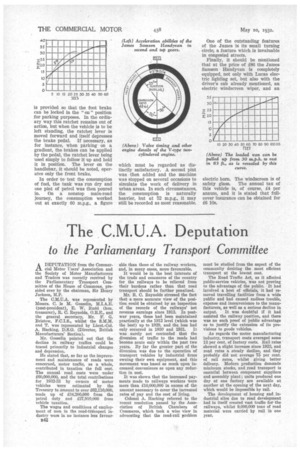The C.M.U.A. Deputation
Page 56

If you've noticed an error in this article please click here to report it so we can fix it.
to the Parliamentary Transport Committee
A DEPUTATION from the Commer1-1 cial Motor Users' Association and the Society of Motor Manufacturers and Traders was recently received by the Parliamentary Transport Committee of the House of Commons, presided over by the chairman, Sir Henry Jackson, M.P.
The C.M.U.A. was represented by Messrs. C. le M. Gosselin, (past-president), E. W. Rudd (hon. treasurer), R. C. Reynolds, 031E., and the general secretary, Mr. P. G. Bristow, F.C.I.S., whilst the S.M.M. and T. was represented by Lieut.-Col. A. Hacking, D.S.O. (Director, British Manufacturers Section).
Mr. Gosselin pointed out that the decline in railway traffics could be traced primarily to industrial changes and depression.
He stated that, so far as the improvement and maintenance of roads were concerned, motor traffic, as a whole, contributed in taxation the full cost The annual road costs were under £60,000,000, and the total contributions for 1932-33 by owners of motor vehicles were estimated by the Treasury to amount to over £62,110,000, made up of £34,200,000 from the petrol duty and £27,910,000 from vehicle taxation.
The wages and conditions of employment of men in the road-transport industry were in no instance less favour
842 able than those of the railway workers, and, in many cases, more favourable.
It would be in the best interests of the trade and commerce of the country for the railways to be relieved from their burdens rather than that road transport should be further penalized.
Mr. R. C. Reynolds stressed the fact that a more accurate view of the position could he obtained by an inspection of the records of the railways' net revenue earnings since 1913. In postwar years, these had been maintained practically at the 1913 level (which was the best) up to 1929, and the loss had
only occurred in 1930 and 1931. It was surely not contended that the diversion of traffic to the roads had become acute only within the past two years. By far the greater part of the diversion was due to the operation of transport vehicles by industrial firms owning their own equipment, and this movement was based as much upon increased convenience as upon any reduction in cost.
It was shown that the increased payments made to railways workers were more than £10,000,000 in excess of the amount necessary to cover the increased rates of pay and the cost of living.
Colonel A. Hacking referred to the recent resolution passed by the Association of British Chambers of Commerce, which took a wise view in advocating that the road-rail problem must be studied from the aspect of the community desiring the most efficient transport at the lowest cost The Road Traffic Act, as it affected public-service vehicles, was not proving to the advantage of the public. It bad involved a host of officials, it bad removed travelling facilities from a wide public and had caused endless trouble, expense and inconvenience to the manufacturers, as well as a serious decline in
output. It was doubtful if it had assisted the railway position, and there was no such proof of public advantage as to justify the extension of its provisions to goods vehicles.
As regards the motor manufacturing industry, transport costs averaged some 13 per cent, of factory costs. Rail rates showed a slight increase since 1923, and road rates a steady decline, and they probably did not average 75 per cent. of rail rates, whilst giving better delivery. Modern production demands minimum stocks, and road transport is essential between component suppliers and assembly plant ; units produced one day at one factory are available at another at the opening of the next day, which would be impossible by rail.
The development of housing and industrial sites due to road development had in itself created vast traffic for the railways, whilst 9,000,000 tons a road material were carried by rail in one year.




























































































